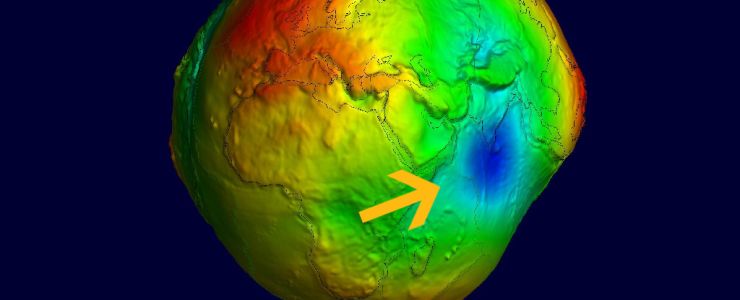
Image: International Centre for Global Earth Models (ICGEM)
A fascinating story from Scientific American: A vast expanse of the Indian Ocean is a staggering 100 meters lower than the global average sea level because of a major dip in Earth’s gravity. Scientists now think they know the cause.
There’s a massive “hole” in the Indian Ocean, researchers say—but it’s not the kind that could drain away all that water. Instead, it’s a term geologists use to describe a spot where Earth’s gravity is lower than average. And a new study may have finally revealed its origins: it appears to be caused by plumes of molten rock rising from deep beneath Africa at the edges of the sinking remnants of an ancient ocean bed.
A pronounced dip in the geoid under the Indian Ocean—called the Indian Ocean geoid low (IOGL)—is the planet’s most prominent gravitational anomaly. It covers more than three million square kilometers and is centered about 1,200 km southwest of the southern tip of India. (Its enormity, as well as the fact that the ocean looks relatively flat at any given point, means the dip isn’t visible at the surface.) As a result of the low pull of gravity there, combined with the higher gravitational pull from the surrounding areas, the sea level of the Indian Ocean over the hole is a whopping 106 meters lower than the global average, says the new study’s senior author Attreyee Ghosh, a geophysicist at the Indian Institute of Science (IISc) in Bangalore.
According to the study’s lead author Debanjan Pal, an IISc doctoral student, the IOGL was discovered in 1948 during a ship-based gravity survey by Dutch geophysicist Felix Andries Vening Meinesz. It has since been confirmed by other shipboard expeditions and by measurements from satellites. But scientists didn’t know why it was there.
To answer that question, Pal and Ghosh compared more than a dozen computer models of how the region formed over the past 140 million years as Earth’s tectonic plates have shifted around. Each model used different variables for the convection of molten material within the mantle.
The results, published in Geophysical Research Letters, indicate the IOGL is present because of a distinctive mantle structure, combined with an adjacent disturbance under Africa called a large low shear velocity province (LLSVP) that is more commonly known as the “African blob.” “What we’re seeing is that hot, low-density material coming from this LLSVP underneath Africa is sitting underneath the Indian Ocean and creating this geoid low,” Ghosh says.
Pal says the geoid low probably took its present shape about 20 million years ago, when the plumes started to spread within the upper mantle. And it will probably last as long as mantle material flows along the plume from the African blob—which is likely to be many more millions of years. But once those flows cease, so will the low. “When the temperature anomalies causing this low geoid to shift out of the present-day location,” Pal says, “the geoid low will start to dissipate.”
Read more at the Scientific American.
